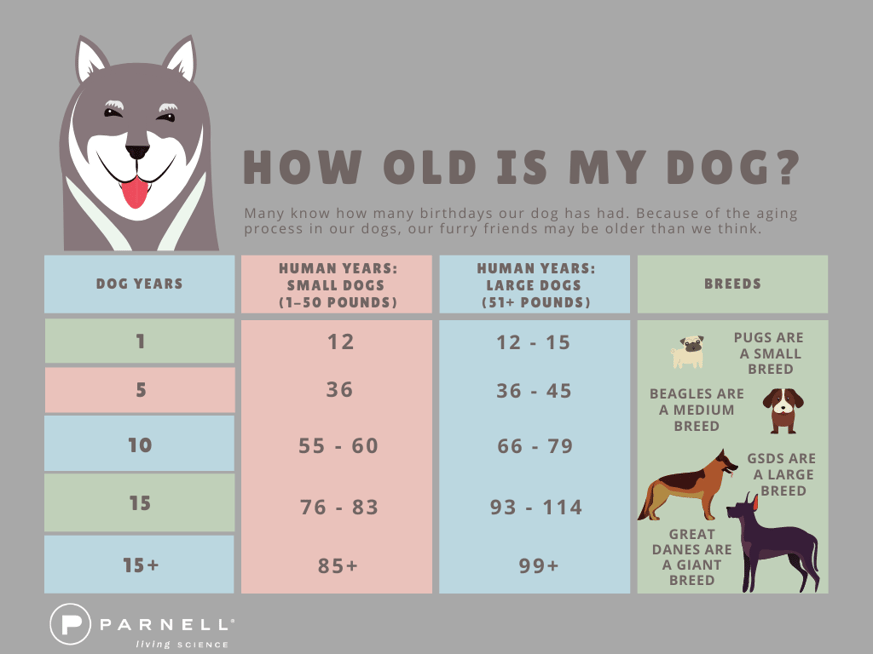A study released in July 2020 helped dispel the myth of using simple math when determining a dog's age. This helped spur a study that began this year in 2022, which is looking at a new group of dogs, the "supercentenarian" in which you can sign your dog up to participate in. The whole process of aging is fascinating to us, especially because we all know our dogs don't live nearly long enough. We are constantly looking for more information that sheds light on how our dog's age.
The top dog-related aging urban myth has many saying to just multiply your dog's age by 7 to get the age of your dog in human years. This was loosely based on a few generalities of aging. Some say the myth used the 7:1 ratio because on average, humans live to be 70 and dogs live to be 10. Thus, the 7:1 ratio was determined. The flaw would be a female dog can have puppies by the first year of age, which is not equivalent to 7 human years.
This new study confirms what veterinarians already believed: dogs age faster in the first few years of their life, then plateau as they age. While the old way may still be acceptable in general, this new tool helps pinpoint more accurately, the exact age of your dog. This information helps veterinarians know when to pay more attention to the aging process of your dog.
While the findings are interesting, the bottom line is still true: our dogs do not live as long as we would like them to. This fact should make it all the more important to be sure your dog is living their best life with you in the time you have with them. Read on to see how the study compares to other ideas on a dog's age.
A recent study from the University of California San Diego School of Medicine illustrates four main stages of age for humans and dogs: juvenile, adolescent, mature and senior. The study charts out aging progression and uses some fun imagery, comparing it to the aging process of the actor, Tom Hanks. This study labels Tom Hanks as a senior at the age of 64, which means dogs could be entering senior status by age 8.
These determinations are a little different than what the American Veterinary Medical Association finds in the aging of dogs. They summarize the aging of dogs like this:
- The first year of a dog’s life equals 15 human years.
- The second year of a dog's life equals 9 human years.
- And after that, each human year would be approximately five years for a dog.
The consensus is dogs age more quickly in the beginning, for years one and two. Thankfully, their aging process slows down as they enter age 3. Of course, there are many factors that impact the aging process for a dog. The size and breed of the dog, the life they live while they are here, and how active they may or may not be.
NEW STUDY: The Dog Aging Project is learning more about aging in dogs with a study on a new age group of dogs: the "supercentenarian" dog. The "supercentenarian" dog are those living at the age of 20 years or older. Researchers hope they will learn why dogs live to age 20 and beyond, and how they can survive so long. The goal is to use these findings to improve both canine and human life longevity. If you have an older dog, you can nominate them for the study.
What is your dog’s age?
We have compiled the latest data from these resources in this easy chart that can help you determine the approximate age of your dog. This chart uses the data available from AKC.
Preventative Health Care Tips Dogs
As our dogs age, health problems start to progress more quickly. Some common illnesses associated with dogs as they age are osteoarthritis (OA) or arthritis in dogs, periodontal disease, diabetes and cancer. Here are action items you can do to help your dog age as gracefully as you are aging:
- Regular well check visits with your veterinarian.
Just like humans, as dogs age, they have more health problems. It is much easier to be proactive and work ahead, then to wait for something to happen. Consult your veterinarian to discuss what you should be aware of for your dog. Most recommend seeing your veterinarian twice a year.
- Keep your dog’s weight in check.
Your dog’s weight has a bigger impact on their health as they age. Dramatic changes in weight, either gaining or losing, can be an early indicator of illness.
- Start a joint supplement such as Glyde™ Mobility Chews.
At age 20, most are able to jump high and run faster. Then at age 40, not as much. Your dog feels the same way. Many pet parents add joint supplements and Glyde Mobility Chews has great results. If you have seen your dog slowing down, consider adding Glyde to help relieve the signs of arthritis and promote better joint health in all ages of dogs.
- Continue playing with your dog.
Keep your dog active throughout their lives, so they stay happy and healthy. Take your dog on a walk, play tug-of-war or fetch to keep your dog acting like the puppy they once were. If you see less interest in playing, and more interest in sleeping, take the initiative to change this pattern.
We all know our dogs are beautiful, fulfilling, wonderful additions to our family. Just as we have always said, the only problem is they don’t live nearly long enough. While we reflect on how our dog ages, let's do our part to make sure they live their best lives while they are here with us and keep them as happy and active as possible!
Resources:




.png)

